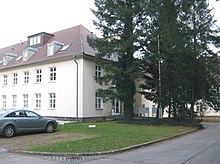Laboratory for Molecular Electronics
The Laboratory for Molecular Electronics in Dresden (AME) was the leading institute in the GDR for research into semiconductor technology .
history
On August 1, 1961, Werner Hartmann founded the "Laboratory for Molecular Electronics" (AME) as a research institute in Dresden, which was initially subordinate to the Office for Nuclear Research and Nuclear Technology and from 1963 to 1965 was subordinate to the Economic Council. From 1965 it belonged to VVB Bauelemente und Vakuumtechnik, which in 1978 became part of the Microelectronics Combine in Erfurt . In the course of time, the institute was restructured and renamed, in 1969 as "Work Center for Molecular Electronics Dresden" (AMD) and in 1976 as "Institute for Microelectronics Dresden" (IMD). In 1980 VEB Elektromat Dresden and the Institute for Microelectronics Dresden were merged to form the “VEB Center for Research and Technology Microelectronics” (ZFTM), which in 1986 was incorporated into the Carl Zeiss Jena combine . The last renaming in GDR times took place in 1987. With the spin-off of VEB Elektromat Dresden, the ZFTM became the VEB Research Center Microelectronics Dresden (ZMD).
Despite all efforts, progress and successes, it was not possible for the GDR to keep pace with the high international dynamics in this area in the long term. After Hartmann's dismissal on July 11, 1974, the Stasi switched to obtaining the information on the continuation of industrial espionage from the leading countries in this area and feeding the results into their own research apparatus.
Web links
- The Federal Commissioner for the Documents of the State Security Service of the former German Democratic Republic (Ed.): Professor Werner Hartmann - Triumph and defeat of the founder of GDR microelectronics . In: Thematic archive - MfS / GDR history.
- Microelectronics in the GDR SED, State Apparatus and State Security in the Contest of Systems (PDF; 1.0 MB), key data on the development of microelectronics in the GDR, pages 138 to 140, accessed on December 17, 2012.
literature
- Silicon Saxony e. V. (Ed.): Silicon Saxony - the story . Verlag edition JS dresden, 2006, ISBN 3-9808680-2-8 , p. 18-80 .

